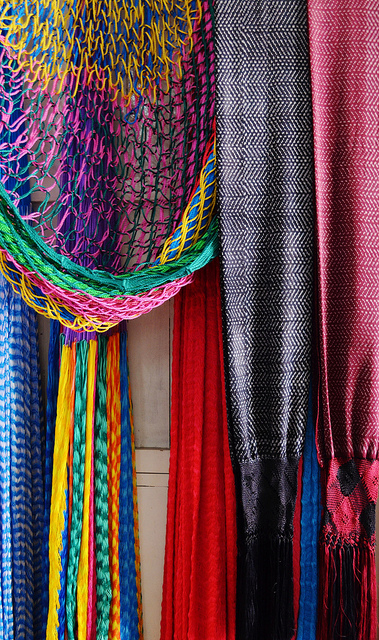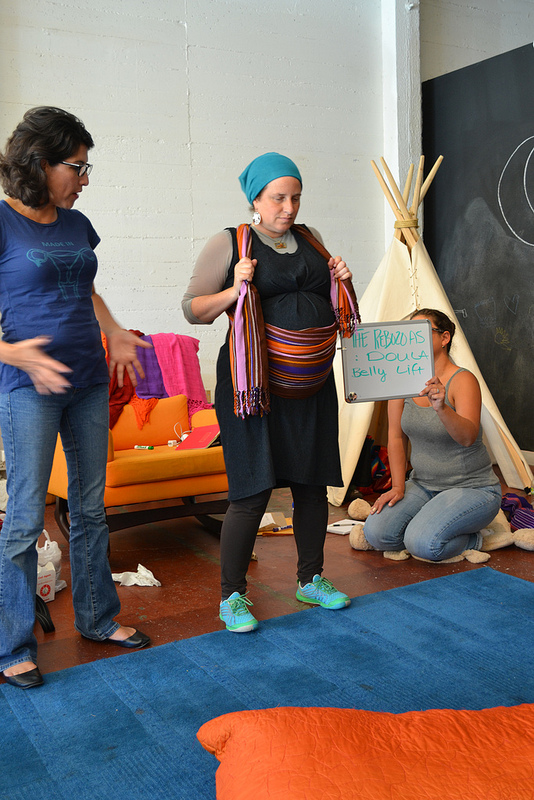I love the rebozo — the beautiful colors, the artistry — but mostly for the way it works…

“Rebozo” means “shawl” in Spanish. It’s a traditional Mexican shawl about 4-5 feet in length. It is a multifunctional tool used before labor, used to help laboring women birth and used for carrying your baby around after birth!
The other day, I wrapped it around one of my patients, sent her out for a walk, and she went from 2-3 cm to 6 cm in an hour.
I’m not saying that a rebozo is for everyone, but I surely tie one on every laboring woman as often as I can.
I researched in-depth for medical and midwifery research with the words “rebozo /labor” in it — “abdominal binder”, “abdominal supporter”, “abdominal girdle”, “abdominal lifting” —to no avail. Perhaps physicians haven’t figured out how to do a valid study on “Rebozo and its effect in labor” much less use it for their patients. One thing that midwives and doulas already know…the Rebozo works.
The rebozo is a cotton or rayon wrap at least 72” to 100” long and at least 29”inches wide. (See www.borntolove.com/frugal on how to make your own) I saw one doula use a pashmina scarf… I was appalled at first, I wouldn’t use an expensive pashmina scarf on a laboring anything. She reassured me that she got it on amazon.com for $5. I didn’t believe it until I saw it on-site. Hmm…something to think about.
“The rebozo is also used in the midwife’s bag. It is a piece of cloth that can be used to wrap around a woman’s belly. The woman who’s had many babies and has a big belly that falls out onto her lap, well, usually the baby is not well aligned in her body. Actually, she may have contractions and have labor for a long time. Even though she’s had babies, baby can’t come out because baby’s resting outside. It’s just out there on the bed or out there in the air, and you need to bring that baby back into her body. The rebozo is a very convenient way of doing it. What I’ve done is lay the woman down and have gravity pull the baby back inside her, and then I tighten the rebozo around, with the knot on the side, so that she cannot feel the knot if she’s leaning. And I just make it nice and tight, usually as tight as I can, because the belly is a huge weight. Then she can get up and have the baby once the baby has fallen back into place. [It positions the baby back over the cervix to help it dilate in labor.]”- Dona Irene Sotelo and Naoli Vinaver
There are many ways that you can use the rebozo:
BEFORE Labor
–As a shawl or a wrap — it’s quite beautiful really, especially as fall season arrives. Instead of purchasing a new scarf for the season, get a wrap and you’ll be able to use it the rest of your pregnancy and for your baby too! (They have them available at www.mayawrap.com you can use it before, during and after… most sell for about $75.)
-You can use it to wrap around your neck for warmth as the chill of fall begins.
-You can tie one around you at the end of your pregnancy (39 weeks or beyond) for a couple hours a day to help support your back by lifting your abdomen so that you don’t feel so “heavy with child”. In Mexico they just leave it on all day long, you figure out how long you want it around your belly.
– It does one more thing that few think about… It causes the baby’s head to apply itself better to your cervix causing a softer cervix. (The “Cook Cascade Theory”, just my theory, but something definitely worth looking into. I’ve seen it work for several of my students.)
- You use the Rebozo to lift your baby, helping relieve your back discomfort;
- The abdominal lifting of the Rebozo helps your baby’s head become better positioned in your pelvis;
- The baby’s head (now better applied in your pelvis) rubs against your cervix which causes a release of endogenous prostaglandins. (Same thing that membrane stripping and intercourse does… but without having something enter your vagina which may be a positive vote at this point in your pregnancy.)
- The release of endogenous prostaglandins causes some Braxton-Hicks contractions which can cause cervical softening, dilation. I tied a rebozo around my friend Marina, (see “Birthing Basics for VBACs” ) she had occasional contractions and it helped her back discomfort and hip discomfort… Before she even went into labor, she was 3 cms dilated.)
This is not a proven method, just a theory based on a few positive experiences, but hey, it could work for you…
DURING Pregnancy & Birth

With Gena Kirby demonstrating how to use the rebozo
-For sifting, jiggling and wrapping!!! A rebozo is multifunctional, it:
- helps you relax in-between contractions (to some women it feels like they are being swaddled, and gently hugged)
- relaxes tight ligaments during pregnancy and in labor
- helps rotate baby’s body into an optimal position and helps “drop the baby into the pelvis” (ESPECIALLY if you’ve had more than one pregnancy… it’s AWESOME for those second, third, fourth-time moms.)
- provides back-pain relief
- helps realign the pelvis in a way that helps your baby move further down (or realigns the baby into the pelvis to help your baby move further down, either way, it’s a good thing.)
- helps provide a tool for comfort that is often overlooked.
- Gives mom’s different pushing /positioning options for 2nd stage of labor.
AFTER birth
- It protects mom’s abdominal muscles after the delivery. For those few who end up with cesarean sections, a rebozo is awesome in supporting your abdomen and provides an amazing amount of pain relief after birth, you’ll use less pain meds and it’s easier to move around after major surgery. For those with normal vaginal births, it helps your abdominal muscles pull your uterus back into your torso and women swear that it decreases back pain AFTER birth.
- Baby carrier!
The Tuck
The fastest and easiest method is a favorite of Mexican grandmothers. The rebozo is wrapped around both shoulders, baby is held in front, and the ends of the rebozo are crossed one over the other and tucked under baby’s bottom. This takes much of baby’s weight off of the arms and can be shifted and adjusted very easily. It’s a great solution when minding baby is your only task at the moment, as you must keep your arms around your cozy bundle.
The Twist
Again fast and easy, this method is often used by busy Indian mothers who need the use of their hands. The rebozo is brought over one shoulder, and the ends are twisted together and tucked under that same arm, creating a pouch similar to modern baby slings. While this may seem terribly insecure to our untrained eye, it is second nature for these women. Baby-minding is a skill that is practiced from an early age, and the rebozo is employed from the very beginning.
The Knot
This is by far the most common method, both in Mexico and Western countries. Rather than twisting the ends of the rebozo, they are tied into a knot. The positioning is the same as the Twist, with the knot placed either in front of the shoulder (corsage area) or pushed around to the small of the back. With this single tying method, baby can be worn in all of the common baby sling positions (cradle, hip, tummy-to-tummy, back, kangaroo). (From www.theBabywearer.com)
Conclusion
The rebozo is a tool often overlooked and underused for birth. Perhaps as the word gets out, women will consider using a rebozo for their birth. Learn how to use a rebozo for your birth through my Comfort Measures Class at www.BirthingBasics.com and then use it afterwards to carry your baby in! A great way to multi-use one item that will help so much during birth and after!
References:
www.BirthingNaturally.net accessed September 3, 2013
www.SpinningBabies.com accessed September 3, 2013
www.theBabywearer.com accessed September 3, 2013
www.yourbirthyourway.ca accessed September 3,2013
- The Rebozo: a transcript of a rebozo workshop given by Doña Irene Sotelo and Naolí Vinaver, published in Midwifery Today (more pictures can be seen by following the link below the photo shown)
- “Comfort Measures for Childbirth: Let’s do it with a Rebozo”–a collection of images by Patti Ramos taken at a rebozo workshop with Guadalupe Trueba, including images of the rebozo used for rocking , putting it over the eyes to block out distractions, to pull on while pushing, and other uses
4 thoughts on “Rebozos in Pregnancy & Birth”
Comments are closed.

[…] maybe a peanut ball, since most hospitals don’t have these yet. Her bag has the essentials: a rebozo, a notebook, food and drink, her phone, extra socks for mom, a hair band, lotions or oils and a few […]
[…] Rebozos in Pregnancy & Birth, from Birthing Basics […]
[…] According to BirthingBasics: […]
[…] Midwives and Doulas use it to help clients advance in their labor stage. Lisa-Marie Cook, from BirthingBasics.net, stated, “I wrapped it around one of my patients, sent her out for a walk, and she went […]